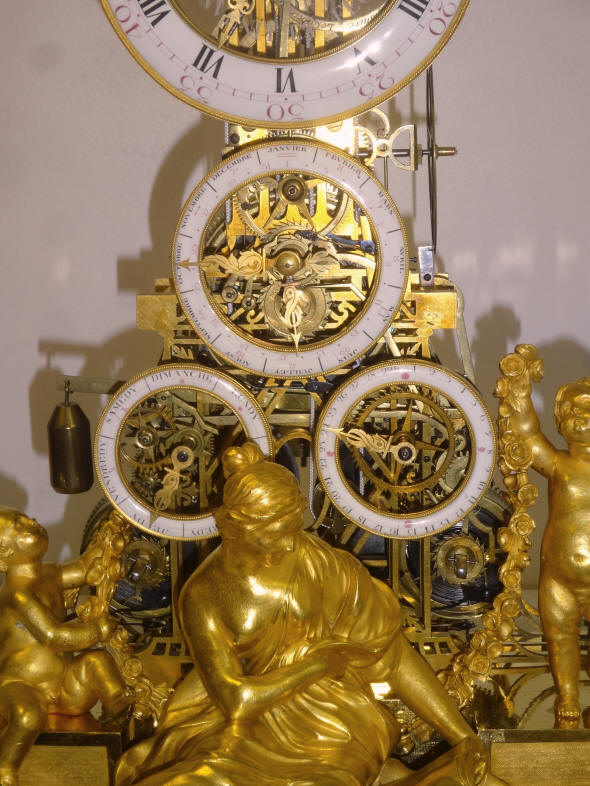|
Maker, Ferdinand Berthoud, Paris, France, c. 1785. Three train pinwheel escapement, 1/2 second gridiron compensated pendulum on knife edge suspension, 30 second Robin remontoire, full perpetual calendar, epicyclical equation of time, moon's age and phase, quarter strike on solar time Chime and strike can be silenced. 25.5"h x 12.25"w x 10.75"d, (65 x 31 x 27.5cm) Below various parts of the frame fretting and decoration are examined in detail. The amount of fretting and decorative cutouts are extensive, especially considering the frames are over 1/8 inch thick, (32mm). These photos show that the frame edges retain their original sharp edges despite the clock's +230 years age. The frames have not had their edges 'rounded over' by to much abrasive polishing or restoration over the years. This carries through to the wheel works. There is an interesting mystery to be explored as revealed in the final few photos on this page.
Here we have a view of the escapement rear pivot point exemplified by the delicate triangular mount, also a portion of the pendulum pivot suspension as well as the gridiron. Although a bit out of focus, one can see that the escapement can be adjusted for depthing as well as drop in relation to the pinwheel.
All three spring barrels are skeletonized from front and rear. The knurl nut in the center allows for the strike to be silenced. Note the variety of styles in the fretting designs in this photo. There is a rectilinear approach as represented in the diamond shape between the bells as well as the main upright shaft of the clock. Yet a curvilinear wave design is represented as well as the French fleur de lis. Lastly an organic leaf design is incorporated into the corners. There is also a delicate curvilinear frame holding the remontoire wheel on the center left of the photo. Notice the oval outline supported by a leaf design on the front frame seen through the rear diamond of the rear frame. This design is not replicated in the rear frame pattern. There is more on this below.
Here we see another juxtaposition of the curvilinear design with the rectangular, ivy and fleur de lis designs. Part of the gilt, cast ormolu is shown below the frame. At this magnification the hand nature of the frames is obvious. What is the mystery of the letter 'O' in the from frame behind the female statuary?
In the first photo one can see the partial oval shape just behind the center sculpture. Next the outline of the frame is drawn over the photo revealing on oval supported by a leaf design. These two photos show the oval as well as the supporting leaf design the first from the front, just behind the center statue and the next from the rear. There has been speculation that this represents the letter 'O' and stands for the initial of the family surname of this clock's original owner. It is unlikely to be an additional decorative item like the other patterns seen in the frames. It is prominently displayed in the center of the front frame and it is not repeated elsewhere, in particular not on the rear frame as would normally be expected. The only name I can come up with is The Duc d' Orleans. He is known to have owned a number of French skeleton clocks at this time. Any helpful information on this topic would be welcome. |
Continental and American Skeleton Clocks, Derek Roberts, p. 24

